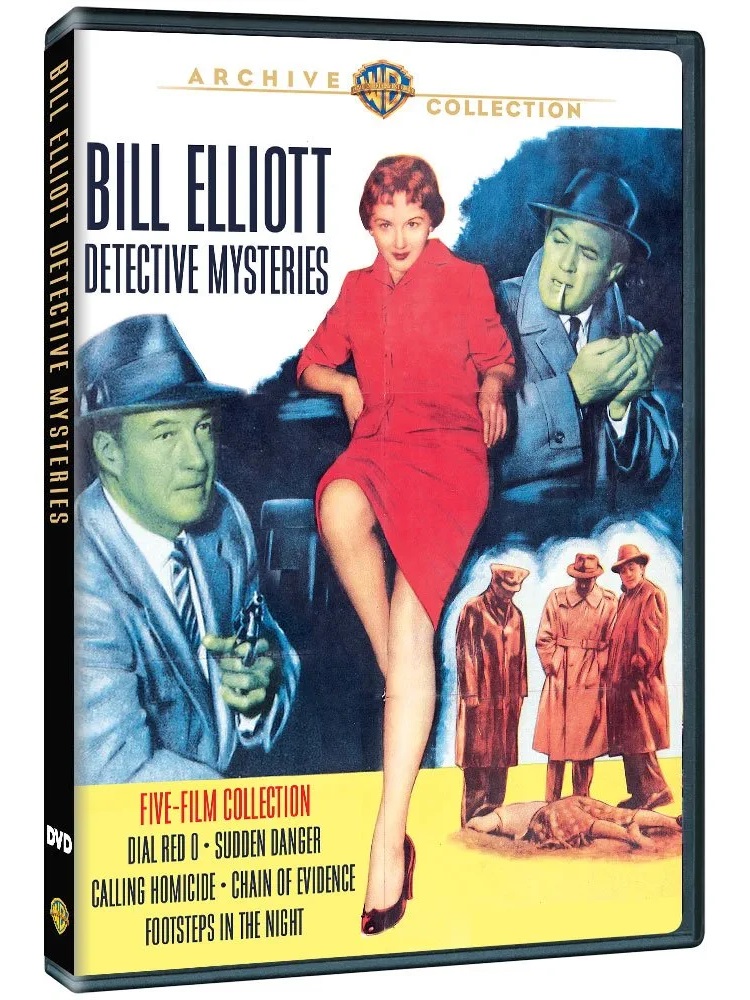
At the tail end of his career in motion pictures, a longtime western star by the name o’ Wild Bill Elliott was forced to contend with several big changes in the film industry. First, the near-legendary Poverty Row studio known today as Monogram Pictures – under whom Elliott had had his final motion picture contract with – went through a transformation. As it morphed into what soon became Allied Artists, the low budgets Monogram cheapies were so well-known (and rather notorious) for ceased to be. Secondly, as television audiences began to crave western shows, the B-Western unit was disbanded entirely. And so, with only five films left to his last contract for any studio anywhere, Elliott himself was forced to make a change: that from cowboy to detective for a short (but still cheap) series from producer Ben Schwalb.
His first venture into this fray was Dial Red O (1955). Ditching his trusty six-shooters for the first time in nearly twenty years, Elliott took the lead in this black-and-white mystery from regular Monogram writer (and first time director) Daniel Ullman. The story finds an ex-GI mental patient (Keith Larsen) escaping from the hospital one afternoon so he can visit his soon-to-be-ex-wife, who has served the poor clod with divorce papers. But when the alleged loon’s spouse (Helene Stanley) is murdered by another party, guess who everyone points the finger at? Thankfully, the seasoned and extremely mellow Lt. Andy Flynn (Elliott) is on the case – and his sidekick sports the name of Columbo (Robert Bice), too! Paul Picerni, Jack Kruchen, and venerable “B” star Rick Vallin co-star. Shorty Rogers makes one of his few film appearances as a bandleader, and an unknown future film icon named Sam Peckinpah has a bit part as a diner cook.
Daniel Ullman returns for scripting duties in the next film, 1955’s Sudden Danger, wherein he is joined in the writing room by Elwood Ullman, best known for his work with The Bowery Boys and The Three Stooges. While not completely established in its brief formulae, the series makes a slight change of its own here by renaming its hero Lt. Andy Doyle for reasons unknown. It also pits him with a new sidekick, as played by John Close. Murder is once again afoot in this tale, where a blind man (Tom Drake) is accused of committing matricide. Beverly Garland is the love-interest of the young co-star (and possible killer), while a slew of familiar faces sporting names such as Minerva Urecal, Lyle Talbot, Frank Jenks, and Lucien Littlefield are also featured.
Yet another change occurs in the third entry of this short-lived franchise, Calling Homicide from 1956, wherein Edward Bernds (another regular The Three Stooges writer) takes over as writer/director. The story centers on the murder of both a police detective, followed by the killing of a modeling school mistress, and, rather amusingly enough, Mr. Elliott – no hero of the dramatic by any stretch of the imagination – answers the titular call for homicide and pretty much phones it in from there (hey, he was close to retirement, alright?!). Don Haggerty (who takes over for John Close here for the remainder of the series), Myron Healy (the suspect), Jeanne Cooper, James Best, Stanley Adams and Mel Welles appear. Former co-stars John Close and Robert Bice appear in different roles, and Lyle Talbot returns in what could be his most flamboyant performance ever (which must be seen to be believed). Still good fun either way you slice it.
Chain of Evidence – the first of the final two films in the series, both released in 1957 – has Elwood Ullman writing Bill Elliott in the backseat a bit so actor Jimmy Lydon can take center stage as a reformed con who winds up with amnesia after a run-in with villainous Timothy Carey and is soon in violation of his parole. Taken in by a kindly benefactor (Hugh Sanders), whose wife (Tina Carver) happens to be scheming to run away from with her secret lover (the great Ross Elliott – no relation) – and the appearance of an amnesiac handyman who tends to get overly-anxious when questioned about his memory makes for a darn good scapegoat. Claudia Barrett (yes, the busty beauty from Robot Monster!) is the young good guy’s true love, Ma and Pa Kettle regular Meg Randall, the always wonderful Dabbs Greer, and Donald Kerr are also in there – as are returning faces John Close (once again as a different character) and another bit by Mr. Peckinpah. Shot in six days.
Finally, we have Footsteps in the Night, which lands Elwood Ullman once more in the writing chair, this time next to future Full Moon Pictures producer Albert Band. The veteran Jean Yarbrough directs this final Elliott/Schwalb hoorah, with Douglas Dick starring as the hapless suspect in a murder, who is accused of killing his neighbor over a gambling debt. Naturally, his gal pal Eleanore Tanin doesn’t believe the cops’ story. And frankly, Lt. Doyle might not, either – but first he’ll have to get to the bottom of things, and there are a number of people to question and co-stars to cast (James Flavin, Harry Tyler, Forrest Taylor, Gregg Palmer, Minerva Urecal, et al). Robert Shayne is the victim, who gets some screen time allotted to him via a flashback. John Close has yet one final part in this series as yet an entirely different character.
The five films in the Bill Elliott Detective Mysteries are presented over two discs, and are shown in a 1.85:1 aspect ratio. The overall picture quality is more-than-adequate, as is the mono English audio. No special features are included with this Warner Archive release, but just seeing the beginning and ending of so many different careers – no matter how many name changes they go through in the process – is a real treat indeed.
Recommended.